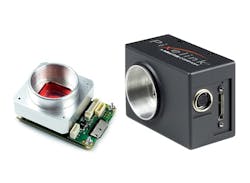Pixelink (Rochester, NY), a Navitar Company and a provider of industrial cameras for the machine vision and microscopy markets, has been chosen in conjunction with Deep Space Systems (Littleton, CO), an engineering services firm with expertise in human and robotic exploration spacecraft design, to supply Pixelink camera technology to NASA.
RELATED ARTICLE: Boosting integrated imaging solutions business, Navitar acquires PixeLINK
NASA chose Pixelink industrial camera technology to be used in three locations on the NASA Orion spacecraft project, which is being built to take humans farther into space than they have ever gone before. This spacecraft and its multi-purpose crew (MPCV) will be using Pixelink technology to capture important imagery of launch and re-entry events including heat shield inspection.
"The Pixelink camera technology provided the best solution for the demanding and rigid performance specifications that the Orion project demanded. These cameras image the Earth and the Moon in order for the spacecraft to independently calculate its position and velocity in Cis-Lunar space," commented Stephen Bailey, president and CEO of Deep Space Systems. "This is critical for crew members onboard when adjusting their entry flight path angle for return to Earth under loss of communication and/or ground based navigation conditions."
Paul Saunders, president of Pixelink, said, "We are committed to providing high quality, durable products. Winning this contract is further testament we are doing just that. We are proud to deliver a dependable application solution to Deep Space Systems and NASA, contributing to the success of Orion, America's next human exploration spacecraft."
Deep Space Systems will repackage, ruggedize and test the Pixelink cameras ensuring each unit withstands the extreme environmental conditions of spaceflight, such as vibration, temperature variances, radiation, dynamics, and vacuum pressure.
SOURCE: Navitar; https://navitar.com/company/news/15/pixelink-awarded-contract-supply-camera-technology/
About the Author

Gail Overton
Senior Editor (2004-2020)
Gail has more than 30 years of engineering, marketing, product management, and editorial experience in the photonics and optical communications industry. Before joining the staff at Laser Focus World in 2004, she held many product management and product marketing roles in the fiber-optics industry, most notably at Hughes (El Segundo, CA), GTE Labs (Waltham, MA), Corning (Corning, NY), Photon Kinetics (Beaverton, OR), and Newport Corporation (Irvine, CA). During her marketing career, Gail published articles in WDM Solutions and Sensors magazine and traveled internationally to conduct product and sales training. Gail received her BS degree in physics, with an emphasis in optics, from San Diego State University in San Diego, CA in May 1986.
